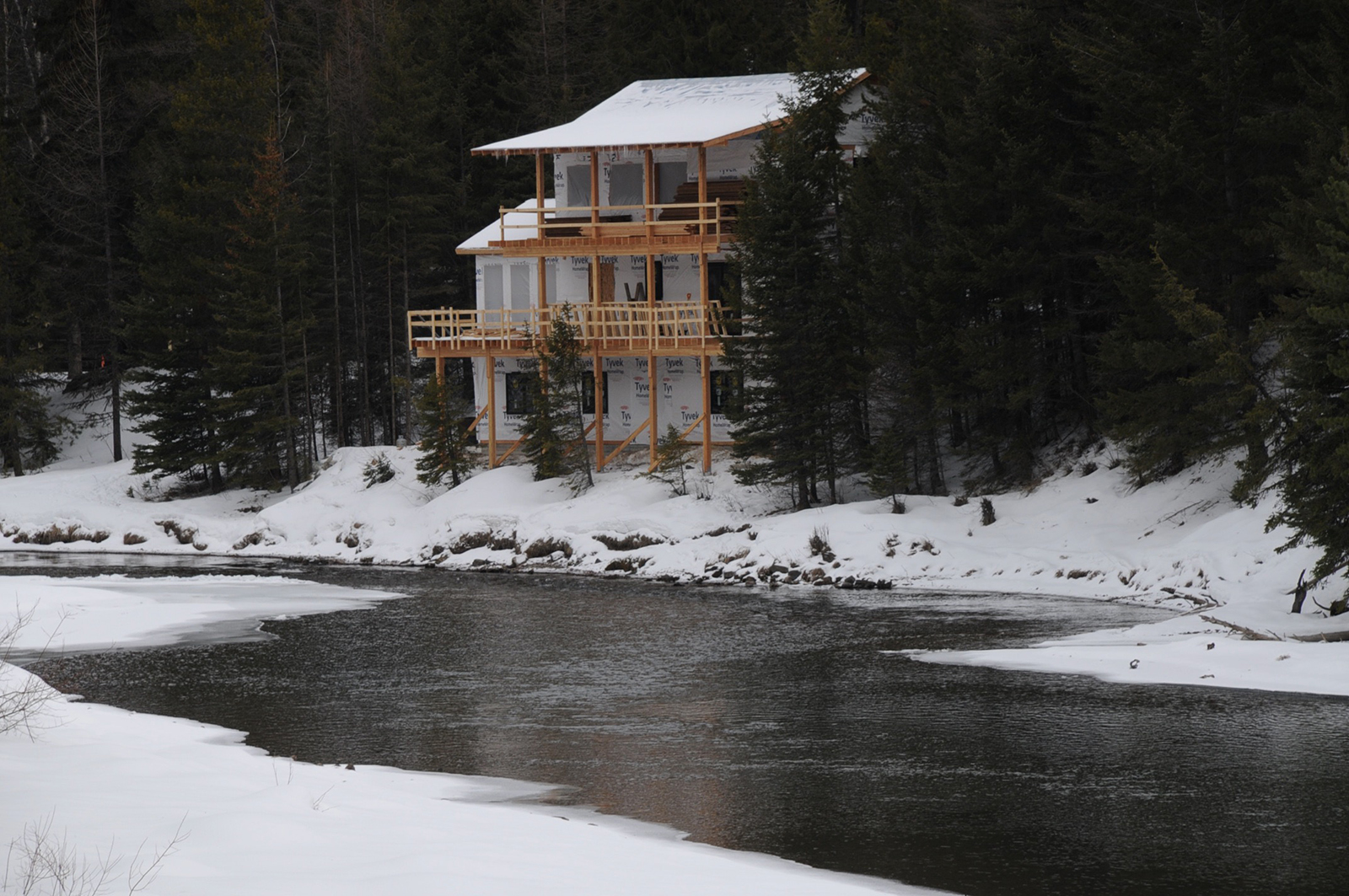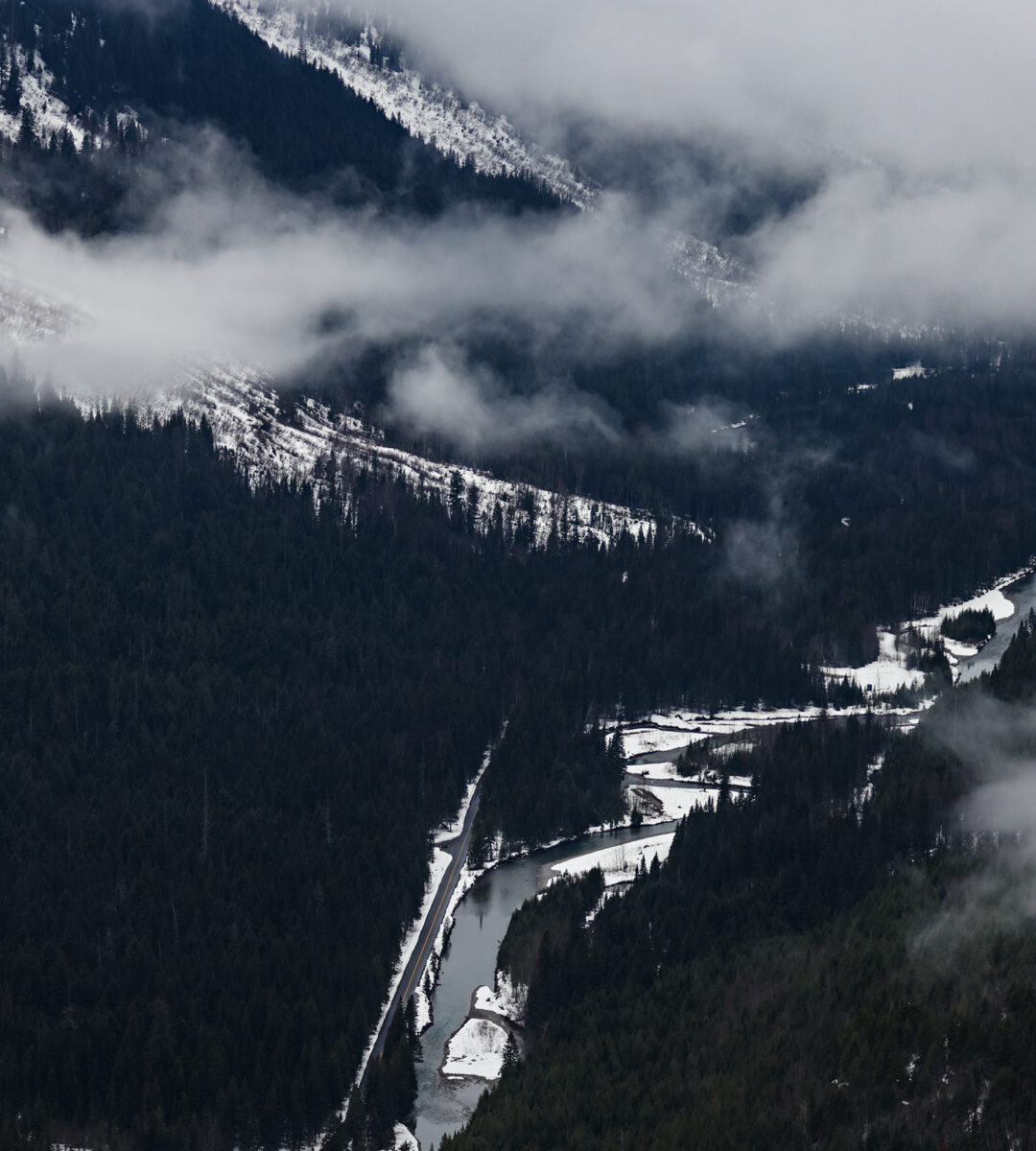Federal Judge to Issue Decision Over McDonald Creek Home Jurisdiction
Calling the arguments "interesting," U.S. Magistrate Judge Kathleen DeSoto must now weigh in on who has exclusive jurisdiction over a home constructed on private land in Glacier National Park — the federal government or the state of Montana — and whether the property is subject to state environmental regulations.
By Tristan Scott
A federal judge in Missoula on Wednesday heard arguments in a case that will determine whether a California couple who built a home on the banks of McDonald Creek in Glacier National Park did so illegally, and if a local conservation district has the authority to order the home’s removal and the streambed’s restoration.
The plaintiffs in the case are John and Stacy Ambler, who sued the Flathead Conservation District (FCD) more than a year ago, seeking relief in U.S. District Court in Missoula, where U.S. Magistrate Judge Kathleen DeSoto concluded the Jan. 8 hearing pledging to “endeavor to get an order as soon as possible.”
The Amblers have asked DeSoto to weigh in on whether the FCD “has jurisdiction and authority to order the Amblers to dismantle a house they are constructing on real property they own in Glacier National Park” and restore portions of the stream bank they excavated. On Wednesday, attorneys for the plaintiffs and the defendants delivered oral arguments on cross motions for summary judgment.
In asserting its authority, attorneys for the FCD argued that the home’s location within the park’s boundaries does not preempt the enforcement of the state’s foremost streambed protection law, the Montana Natural Streambed and Land Protection Act (NSLPA). In the absence of analogous federal law, FCD attorney Camisha Sawtelle said criteria surrounding the construction of a home on a private parcel girded by National Park Service land should default to the state law’s regulatory arm.
Meanwhile, the Amblers say only Glacier National Park can govern private inholdings, stating the FCD “cannot unilaterally reassert jurisdiction over lands to which the State of Montana long ago ceded jurisdiction to the United States.”
“The only issue in this case is federal versus state jurisdiction over the Amblers’ property,” according to the plaintiffs’ motion for summary judgment, which asks the judge to rule in favor of the couple and resolve the jurisdictional question without going to trial.
The case began locally when residents in the West Glacier area complained about the construction project, clearly visible to park visitors and neighbors, which prompted FCD to conduct an onsite inspection. Following the inspection, FCD determined the Amblers had violated the NSLPA (better known as the 310 law) by building on an immediate bank of McDonald Creek and excavating the stream bank to create a pad for construction, all without obtaining the necessary 310 permit, the statute’s key enforcement provision.
The FCD ruled that the Amblers must remove the home and remediate the streambed. However, the couple challenged the FCD’s jurisdictional authority in the case and proceeded to what’s called a declaratory ruling process, which was overseen by hearing officer Laurie Zeller, a retired bureau chief with the Montana Department of Natural Resources and Conservation (DNRC).
After reaffirming its jurisdictional authority, Zeller remanded the case back to the FCD, whose Board of Supervisors ruled that the couple must remove the home and repair the streambed no later than April 1, 2024.
Instead, the Amblers filed lawsuits in state and federal courts, arguing that the FCD overstepped its authority by ordering the home’s removal. As the legal saga drags on, the unfinished home remains visible to onlookers from the Camas Road.
The question at the center of this week’s oral arguments was whether FCD has jurisdiction to enforce the 310 law, which states that any private individual or entity proposing work in or near a stream that “physically alters or modifies the bed or immediate banks of a perennial-flowing stream” must first obtain an approved permit from the local conservation district.
According to the Amblers, neither Flathead County nor Glacier National Park required any permits to begin construction on the property and connect the residence to the Apgar Village water and sewer system.
“Glacier National Park allowed the construction and allowed the Amblers to connect to the Apgar Village water and sewer system,” the federal complaint from the plaintiffs states. “The Amblers dispute that the FCD has jurisdiction over the property and dispute that the NSLPA applies to the property.”
Members of the FCD’s Board of Supervisors attended Wednesday’s court proceedings, as did a group of West Glacier and Apgar residents who joined the lawsuit as intervenors in the case, both to support the FCD’s position as well as to represent themselves as stakeholders. The group, called Friends of Montana’s Streams and Rivers (FMSR), has separate legal counsel than the FCD. Attorney Rob Farris-Olsen delivered arguments Wednesday on behalf of FMSR.

Both Sawtelle, representing FCD, and Farris-Olsen, for FMSR, argued that in the absence of a federal statute that specifically grants the National Park Service authority to regulate the construction of homes on private land within its boundaries, or that otherwise conflicts with or overwrites Montana’s 310 law, the state statute is applicable.
“My position is that the 310 law applies to Glacier National Park. That anyone doing work within the immediate banks of a perennial-flowing stream is required to get a 310 permit,” Sawtelle said. “There is case law, your Honor, that tells us that, essentially, we don’t want these properties unregulated. That these lands can’t just operate in a void. So lacking any conflicting federal law, the state law can and should apply.”
The case is unique given the project’s location inside Glacier National Park, which when established in 1910 trapped private tracts of land staked by homesteaders prior to the park’s existence. Originally totaling 13,000 acres, many of the homesteaders sold, or “ceded,” their property to the National Park Service a century ago, but some remain. Known as “inholding,” the bill establishing Glacier Park was explicit in its concession that landowners would retain “full use and enjoyment of their properties” and that “nothing herein contained shall affect any valid existing claim, location or entry under the land rules of the United States, or the rights of any such claimant.”
In other words, state law applies to the inholdings.
But DeSoto said her interpretation of underlying case law is that “the state laws that existed at the time of the cession are assimilated.” Applying that logic, it’s not extraordinary for the federal court to, for example, adjudicate water rights or easements inside the park’s boundaries because there was a body of state law governing water rights and easements prior to the creation of Glacier National Park.
“But the 310 law was a completely new statute that was created many decades after the creation of Glacier National Park,” DeSoto said.
Although Sawtelle said “it’s unfortunate that [the park] hasn’t incorporated the 310 law,” or drafted one of its own, it’s understandable that adopting a federal statute analogous to the NSLPA hasn’t emerged as a top priority for park administrators, given that the purpose of Glacier National Park is to protect the 1-million-acre reserve of natural resources and wildlife within its boundaries, and not to facilitate the construction of new homes or summer cottages.
“If you look at the purpose of Glacier National Park and the purpose of the 310 law, the intention of the underlying policy is to protect the resources,” Sawtelle said. “It says let’s not have people digging out a perennial stream in Glacier National Park. The private inholdings in Glacier National Park are subject to state law unless there’s conflicting federal law.”
Sawtelle said while it’s clear the federal government has the authority to adopt its own version of the 310 statute, the local rules should apply to private inholdings in its absence.
“Rather than accepting the result that this is a void, lacking any federal law, this state law must apply,” Sawtelle said.
That’s not how Trent Baker of Datsopoulos, MacDonald & Lind, a Missoula-based law firm representing the Amblers, sees it. To Baker’s understanding of case law, there’s no question as to whether the federal government accepted sovereignty and political dominion over the state land ceded to it more than a century ago at the time of Glacier Park’s creation. The question is whether a political subsidiary of the state, such as FCD, can enforce the provisions of a state law that didn’t exist when the land was ceded.
“There was nothing like this law in place at the time of the cession in the early 1900s,” Baker said. “I mean, this law was enacted decades later. It was conceived as an enforcement tool for agricultural users engaging in irrigation diversion and agricultural activities that might affect the stream. Conservation districts would basically regulate the activities and grant permits to allow these activities to occur and to minimize impacts on streams as a result of those activities. But there was nothing like that on the books back [when the Amblers’ land was ceded]. At least nothing that I’ve seen.”